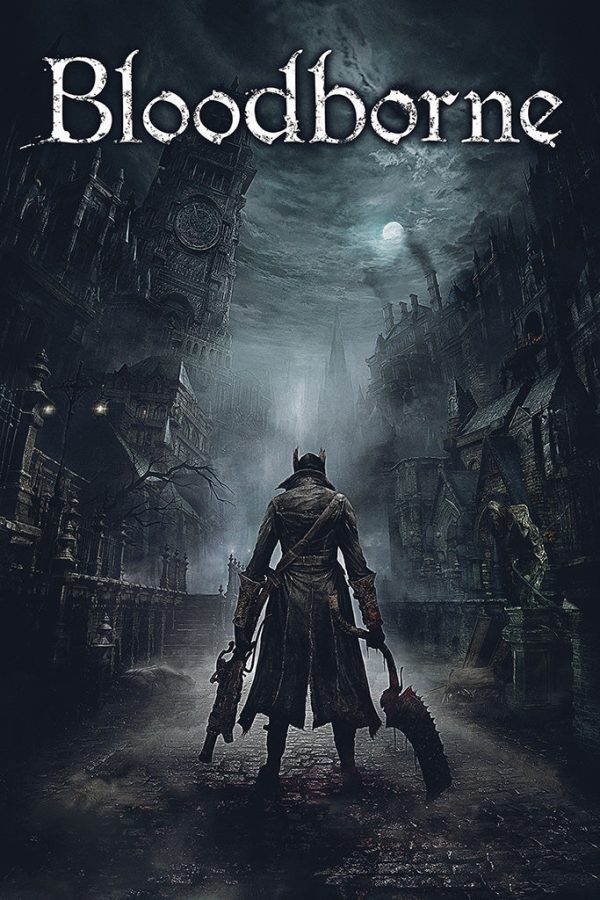Bloodborne is a masterpiece in gameplay, worldbuilding and horror
“Bloodborne,” released Mar. 24, 2015, was developed by “Dark Souls” developer FromSoftware. “Bloodborne” is the evolution of the “souls-like” formula and is one of the greatest PlayStation exclusive games that released on the PS4. (Photo courtesy of FromSoftware)
March 15, 2023
When “Elden Ring” came out, I had a friend constantly pressure me to buy it so we could play together. I was intimidated and didn’t want to spend the $60, so I decided to play a game that was sitting in my PlayStation library for seven years, “Bloodborne.” I expected a game that I would get frustrated at and put down an hour or two later out of frustration.
What I found was a fun and challenging experience mixed with an immersive, horrific world.
“Bloodborne,” released March 24, 2015, was developed by FromSoftware and published by Sony Computer Entertainment. You play as a beast hunter and travel through the Gothic Victorian-era–inspired city of Yharnam seeking answers for the cause of a disease that turns the city’s citizens into terrifying beasts.
“Bloodborne” is the fourth take on the Soulslike genre which FromSoftware popularized, creating “Demon’s Souls,” “Dark Souls” and “Dark Souls II” beforehand. While these other games are great in their own right, “Bloodborne” was where FromSoftware made leaps and bounds with their gameplay.
This game takes the “Dark Souls” formula of challenging gameplay and refines it by speeding up combat and giving the player a better quality of tools to fight with.

I say tools, not weapons, as different weapons are effective toward different enemies. While there isn’t as much diversity in weapons as in “Dark Souls,” there is a smaller, but stronger selection of weapons that allow for the player to succeed. Each weapon has two modes. Switching modes are quick and seamless, giving the player more flexibility in engaging an enemy. One mode may be better for quick swipes while another may allow for a large burst of damage.
The weapons mix masterfully with the game’s combat pacing. Instead of standing still to heal like in “Dark Souls,” you quickly jab yourself and get back to the fight. Not only that, but the mechanics of regaining health by quickly damaging the last enemy that hurt you encourage the player to play aggressively. It modernized the dance-like fights FromSoftware was going for in other “Souls” games and works well with the enemies you fight.
The diverse palette of beasts you fight is immense. Each area you enter has new creatures you fight with different move sets. Entering a new area and seeing a large indescribable beast block your path really pushes the player to not only face their fears but improve at the game. Common enemies, as well as boss fights, have been improved to be more enjoyable to fight, but also challenge the player a lot more compared to “Dark Souls.”
You will die over and over again, but the way the game encourages you to keep pushing forward is by exploring, and “Bloodborne’s” world is worth exploring.

It cannot be understated how excellent the world design of “Bloodborne” is. Yharnam is a horrifically beautiful world. Every ounce of potential is fully realized in this bleak and hopeless environment because of the horror angle the game goes for. I love horror because it feels like it is where art is at its most creative. Making something that unsettles, confuses or horrifies someone requires a lot of skill not only to make but to fully realize it in the medium of video games.
Other FromSoftware games like “Dark Souls,” “Sekiro: Shadows Die Twice” and “Elden Ring” have rich, detailed worlds as well. None of these games immerse me as much as “Bloodborne” does, and the biggest factor is the music.
When the composers for “Bloodborne,” Tsukasa Saitoh, Yuka Kitamura and Nobuyoshi Suzuki, were creating the soundtrack for the game, they focused on two main ideas, horror and mortal struggle. They absolutely hit the nail on the head with the music in this game.
The songs have this delicate balance of fast and strong songs for high-action boss fights, such as “Ludwig, the Holy Blade,” and slower somber songs for fights that carry a lot more emotional weight, such as “The First Hunter.” The music completes this game and would not be the same without it. It’s one thing seeing how bad the world of Yharnam is, but hearing the pain, sorrow and horror through an orchestra is a completely different feeling.

While the musical score of “Dark Souls” or “Elden Ring” is a choir of warriors cheering you on to victory, “Bloodborne’s” musical score is a sea of tortured souls wailing out into the void until the eventual end of the world. It is oppressive and completes the main idea of “Bloodborne’s” world.
Through the game, you meet dozens of characters wandering through this nightmare. As the world continually becomes more depraved, it seems impossible anyone would be left alive or unaltered by the disease spread throughout the world. “Bloodborne’s” true horror isn’t the Gothic setting or the indescribable beasts you fight, it is the idea that no matter how much you fight for change, nothing ever changes. You either die or become a cog of the elaborate horrific machine of this game’s world.
“Bloodborne” proved to me that FromSoftware’s games aren’t popular because of their difficulty. It is because the developers truly realize and commit to their artistic vision with each game they make, with this game being their crown jewel.
If you have a PlayStation 4 or 5, I cannot recommend “Bloodborne” enough.








